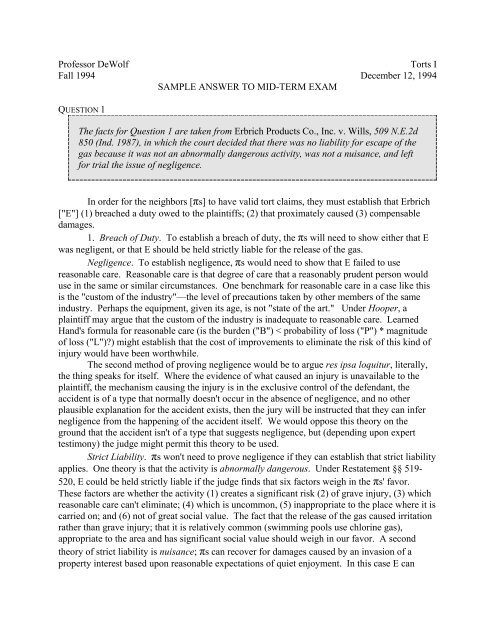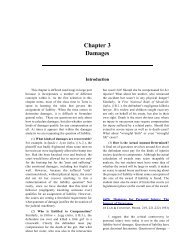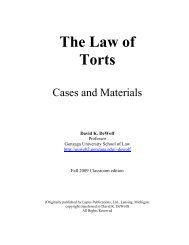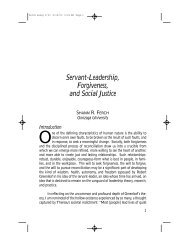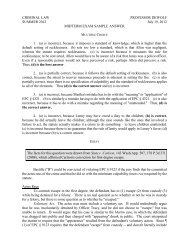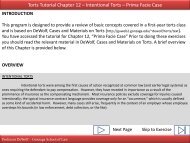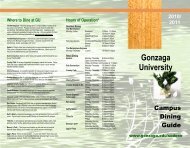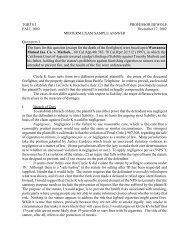The facts for Question 1 are taken from Erbrich Products Co., Inc. v ...
The facts for Question 1 are taken from Erbrich Products Co., Inc. v ...
The facts for Question 1 are taken from Erbrich Products Co., Inc. v ...
You also want an ePaper? Increase the reach of your titles
YUMPU automatically turns print PDFs into web optimized ePapers that Google loves.
DeWolf, Torts I Sample Answer, Fall '94 Mid-Term Page 2argue that the πs "came to the nuisance": that because the industrial nature of the <strong>are</strong>a at thetime the activity first began, the πs couldn't have a reasonable expectation that they should befree <strong>from</strong> it. On the other hand, the πs may say that the change in the neighborhood was anatural evolution and that their expectation to be free <strong>from</strong> random releases of gas is a reasonableone. Tough call.2. Proximate Cause. <strong>The</strong> πs must show that the breach was a proximate cause ofdamage. In this case it would be easy to say that, but <strong>for</strong> the release of the gas (assuming that isfound to be a breach of duty), πs would not have been injured. Also, it is a legal cause of theinjury, since it occurred in a direct and unbroken sequence.3. <strong>Co</strong>mpensable Damage. Even if there was a breach of duty, it must proximatelycause a legally recognized <strong>for</strong>m of damages. Any of the plaintiffs who suffered property damagecan recover the lesser of (1) the cost to repair; or (2) the difference in fair market value be<strong>for</strong>eand after the injury. Any of the πs who suffered physical injury may recover the following:wage loss <strong>for</strong> any work that they missed, medical expenses, and pain and suffering, includingany fear and anxiety associated with the release. On the other hand, those who have not sufferedphysical injury, but claim emotional injury, such as grief caused by injury to a child or lovedone, or anxiety or fear of future injury—such claims would ordinarily not be compensable.However, if a π was a bystander to a severe injury, or if the emotional injury was especiallyconvincing, the court might permit a recovery even in the absence of physical injury.QUESTION 2<strong>The</strong> <strong>facts</strong> <strong>for</strong> <strong>Question</strong> 2 <strong>are</strong> <strong>taken</strong> <strong>from</strong> Fleege v. Cimpl, 305 N.W.2d 409 (S.D. 1981), inwhich the court decided that strict liability did not apply but the jury should have beeninstructed on res ipsa loquitur.I would recommend considering an action against Azure Resort and <strong>Co</strong>untry Club, andpossibly against the installer and/or seller of the motor/pump. To succeed, Nancy would need toshow a breach of duty, proximate cause and damages.1. Breach of Duty (Azure). One <strong>for</strong>m of breach of duty would be negligence. If Azurefailed to use the c<strong>are</strong> of a reasonably prudent person, they could be found negligent. <strong>The</strong>re issignificant evidence that the pump was installed in a negligent manner, with wires improperlyspliced. It may also be that in consulting with others who use pumps like this that there is acustom of the industry comp<strong>are</strong>d to which this installation was unsafe. If Azure either installedit itself, or had control over the manner in which it was installed, they could be considerednegligent. I would also consider a claim based upon res ipsa, since this might be an accident thatdoesn't ordinarily occur in the absence of negligence, where the instrumentality causing theinjury was under the exclusive control of the defendants, and other plausible explanations havebeen eliminated. However, there <strong>are</strong> issues about control in this case, and there is also somequestion as to what really caused the injury. Thus, the judge might not allow a res ipsainstruction on these <strong>facts</strong>.Strict Liability. <strong>The</strong> only claim that would not require proof of negligence is to arguethat Azure was engaged in an abnormally dangerous activity. Nancy would need to establish
DeWolf, Torts I Sample Answer, Fall '94 Mid-Term Page 3strict liability based upon six factors: whether the activity (1) creates a significant risk (2) ofgrave injury, (3) which reasonable c<strong>are</strong> can't eliminate; (4) which is uncommon, (5)inappropriate to the place where it is carried on; and (6) not of great social value. Becausereasonable c<strong>are</strong> would eliminate the risk, and the use of electricity is very common, appropriateto where it is carried on, and of significant social value, strict liability would be an unlikelychoice.Breach of Duty (Installer/Seller). If the negligent installation was per<strong>for</strong>med by anindependent party, they could be held liable <strong>for</strong> reasons similar to those discussed in relation toAzure. Also, it may be that the motor itself contained some kind of electrical anomaly; it is notclear <strong>from</strong> the <strong>facts</strong> as to what the most likely explanation is <strong>for</strong> the excess electricity. Perhaps <strong>are</strong>s ipsa loquitur theory could be brought relative to a possible defect in the motor, but again wewould have problems showing that the instrumentality was in anybody's exclusive control2. Proximate Cause. <strong>The</strong> major problem in this case will be to establish proximatecause. To establish proximate cause, Nancy must establish that, more probably than not, theinjury to her son would not have occurred but <strong>for</strong> the defendants' breach of duty; and that thebreach of duty led by a direct and unbroken sequence to the injury. <strong>The</strong> experts' testimony isconflicting, but on the basis of this testimony, plus the evidence <strong>from</strong> other witnesses, a jurycould believe that, more probably than not, it was the defendant's negligence that created anelectrical charge in the water, causing James' death. On the other hand, the jury might find theevidence unconvincing, and that the plaintiffs did not meet their burden of proof. But if the juryfinds that the defendants' negligence was a but-<strong>for</strong> cause of the death, they would have noproblem finding that it was a legal cause; it occurred in a direct and unbroken sequence, and itwas neither a result of mere chance, there was no superseding cause of the injury, and theplaintiff was within the zone of danger, and thus <strong>for</strong>eseeable.3. Damages. If liability is established, Nancy's right to recover damages isdetermined by the statute. G.S. § 28A-18-1 and -2 gives the personal representative a right tofile an action <strong>for</strong> wrongful death; § -2 states the remedies that the personal representative isentitled to collect. <strong>The</strong> remedies <strong>are</strong> relatively generous. <strong>The</strong>y include (1) the economic losssuffered as a result of premature death (the income James would have earned throughout hislifetime, discounted to its present value), (2) the loss of "services" (such as helping around thehouse), plus (3) the loss of society and companionship. <strong>The</strong> latter would allow Nancy to tell thejury how much she would suffer as a result of the lost relationship with her son. Properlypresented, that could be a significant sum. Finally, in the event that the negligence of one of thedefendants could be shown to be so extreme as to demonstrate a reckless disregard <strong>for</strong> the safetyof others, the court might permit the jury to award punitive damages.
DeWolf, Torts I Sample Answer, Fall '94 Mid-Term Page 5Exam Number __________


